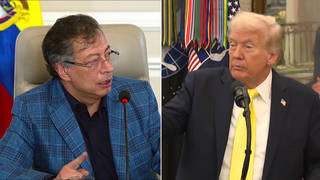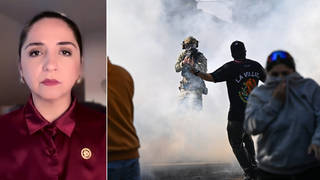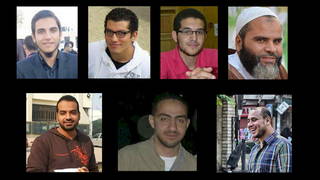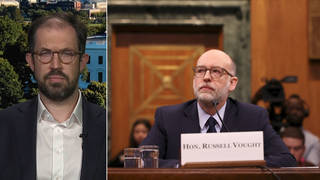
Journalist Jane Mayer outlines her major new article in The New Yorker on the practice known as “extraordinary rendition,” where prisoners, such as Maher Arar, are shipped to countries known for their poor human rights records and history of torture. [includes rush transcript]
Alberto Gonzalez was sworn in this week as the new US Attorney General amidst ongoing criticism from human rights groups and Congressional Democrats that Bush appointed a man who called the Geneva Conventions “quaint” and gave legal cover for the torture of prisoners at Abu Ghraib and Guantanamo Bay. Meanwhile, a major piece in last week’s New Yorker magazine documents the practice known as “extraordinary rendition,” where prisoners are shipped to countries known for their poor human rights records and history of torture. The piece is called “Outsourcing Torture” by Jane Mayer and it documents the increased use of rendition since 2001. One of the cases she writes about is a case we have covered extensively on this program. And that is the case of Canadian citizen Maher Arar. Two years ago the Syrian-born software engineer was detained by US officials while on a stopover in New York. He was then jailed and secretly deported to Syria. He was held for almost a year without charge in an underground cell not much larger than a grave, where he was tortured. Time Magazine in Canada named him the country’s newsmaker of 2004.
- Maher Arar, archived Democracy Now! interview from November 2003 shortly after he returned to Canada from Syria.
- Jane Mayer, journalist with The New Yorker. Her most recent piece is “Outsourcing Torture: The Secret History of America’s 'Extraordinary Rendition'”
Transcript
AMY GOODMAN: One of the cases she writes about we’ve covered extensively here on Democracy Now! It’s the case of the Canadian citizen, Maher Arar. Two years ago, the Syrian-born software engineer was detained by U.S. officials while he was transiting through Kennedy airport. He was then jailed and secretly deported to Syria, held for almost a year without charge in an underground cell not much larger than a grave where he was tortured. Time magazine in Canada named him “Canada’s Newsmaker of 2004.” A year before, in November 2003, we spoke to Maher Arar about the torture he endured in Syria. We reached him shortly after he had returned to Canada.
MAHER ARAR: Really, I mean, when I arrived there, I just couldn’t believe it. I just — I felt first it was a dream. I was crying all time. I was disoriented. I wished I had something in my hand to kill myself, cause I knew I was going to be tortured and this was my preoccupation. That’s all I was thinking about when I was on the plane. And I arrived there. I was crying all time.
So, one of them started questioning me and the others were taking notes. And first day it was mainly routine questions between eight to twelve. And the second day, that’s when the beatings started. Cause, you know, on the first day they did not find anything strange about what I told them and they started it — they started beating me with a cable, electrical threaded cable, and they would beat me for three, four times. They would stop again and they would ask — they asked questions again and they always kept telling me, 'You are a liar,' and things like that. So, the beating continued for the first two weeks. The most — the most intensive — the intensive beating was really the first week and then after that, it was mostly slapping, punching on the face and hitting. So, on the third day when they didn’t find anything — third or fourth day — they — In my, they just wanted to please the Americans and they had to find something on me; so, because I was accused of being an al Qaeda member, which is nowadays synonymous with Afghanistan, they told me, ’You’ve been to a training camp in Afghanistan.’ And I said, 'No,' and they started beating me. And I said — Well, I had no choice. I just wanted the beating to stop. I said, 'Of course, I've been to Afghanistan.’ I was ready to confess to anything just to stop the torture.
AMY GOODMAN: Maher Arar, a 34-year-old graduate of McGill University in Canada, whose family emigrated there when he was still a teenager, sent to Syria by the United States.
We’re joined now by Jane Mayer, she writes for the New Yorker magazine. Her latest piece, “Outsourcing Torture: The Secret History of America’s Extraordinary Rendition Program.” Her piece begins with Maher Arar. Juan.
JUAN GONZALEZ: Welcome to Democracy Now!, Jane.
JANE MAYER: Thanks so much. I’m very glad to be there.
JUAN GONZALEZ: Your article clearly documents that his case was not — was not a lone example, but that there have been many, many cases of these renditions. Could you talk a little bit about what you found?
JANE MAYER: Yes. That is what the story focuses on, which is that there is a secret program that’s run by the C.I.A. mostly (though the Justice Department and the Defense Department also do renditions), and it started — [sneeze] excuse me — in the mid 1990’s, actually, in the Clinton administration, as a way of deporting or extraditing criminal suspects, usually terrorist suspects, back to countries that had some kind of legal claim on them. Most of them were sent back to Egypt, and most of them there were outstanding arrest warrants for; but what happened after 9/11 is the program, according to the people that I interviewed, spun basically in many ways out of control. It expanded exponentially, so that there are now thought to have been anywhere between 100 and many more such individuals who’ve been 'renditioned,' as they call it; and, instead of waiting until there are formal arrest warrants for these people and a — kind of a legal case that’s been carefully built up against them, it appears that some of these people have just been basically picked up on kind of untested suspicions, such as Maher Arar, against whom there turned out to be no case whatsoever. The Syrian government eventually released him after Canada pressured the Syrian government to let him go, and the Syrians said, 'Well, we never found anything wrong with him. He seems completely innocent.' So, it, of course, makes one wonder how many other people there might be who are completely innocent, who have been sent by the U.S. to countries where they’ve been interrogated, and in some instances it seems tortured.
JUAN GONZALEZ: Now, your article also makes a extraordinary revelation about what could have been the possible cause of the 1998 bombings in — of the American embassies in Kenya and Tanzania related to a special — one of the special operations that was occurring in Albania connected to the Egyptian government. Could you explain that? What happened there?
JANE MAYER: Yeah. Well, they — in 1998, in one of the early ones of these extraordinary renditions that was carried out by the C.I.A., a number of terror suspects were picked up in Albania by the U.S. and along with some local agents; and some of the suspects were killed in a gun battle, others were abducted and interrogated on a ship in the Adriatic Sea. And they were eventually — those that survived — were sent back to Egypt for further interrogation, where some of them vanished and were thought to have been killed. And soon after this all took place, there was an article in a newspaper in London, an Arab newspaper in London, that was about this process, and said, 'We are going to retaliate in language that the U.S. understands;' and shortly after that, the U.S. embassies were blown up. Now, I don’t really know whether there’s a causal link there. I think it’s speculation, and there’re plenty of people who would suggest that it would have — the planning for the bombing of the embassies would have had to take place earlier than that. So, I don’t know how closely you want to rely on that causal link; but it is clear that if the U.S. is going to be abducting individuals around the world, and just spiriting them away to be tortured or whatever, you can’t do these things secretly, really secretly anymore. The world’s a small place and people are watching; and, you know, somebody disappears, the family knows and their colleagues know, and so eventually, these things do get out.
AMY GOODMAN: Jane Mayer, you write about the U.S. gaining custody of its first high-ranking al Qaeda figure, Ibn al-Shaykh al-Libi, and you talk about how he was used by Colin Powell in his U.N. address to make a link between al Qaeda and Iraq. Can you talk about what happened to him, his story?
JANE MAYER: Yes. I’m so glad you asked about that. Many people haven’t focused on it, but I thought it was so interesting. There was actually a tug-of-war between the C.I.A. and the F.B.I. for this man; and the interesting thing is that the F.B.I. is really — has been quite against the idea of torturing people, or interrogating them in ways that are illegal. The C.I.A. has wanted to choose a much rougher path, and in this case the C.I.A. won out. They got custody of this guy. They apparently renditioned him to Egypt where the rumor at the F.B.I. was that he was very roughly treated, and eventually, he became the source for information in Colin Powell’s address to the United Nations, the momentous one in which he made the case for going to war in Iraq. And what happened was the suspect had told U.S. officials, as he was being interrogated, that there was some connection between al Qaeda and Saddam Hussein on weapons of mass destruction and chemical warfare. This is, of course, what the administration was hoping to hear. Later, the suspect recanted, said he’d made it all up. Under the circumstances that he was being held, I guess he felt that he needed to say whatever they wanted to hear. It turned out not to be true. So, I think that the case illustrates the perils of torturing people, or of — you know, of coercing confessions out of people, just as Maher Arar told you in the sound bite that you played earlier. People will say whatever they think their captors want to hear. And so, instead of getting the truth from someone, you may be getting, you know, a complete lie; but it’s an unreliable source of intelligence cause it’s hard to tell what’s true and what’s not true under those circumstances.
JUAN GONZALEZ: In your article, you resurrect a quote from Vice President Dick Cheney that he made in an interview on “Meet the Press,” and the quote goes: “A lot of what needs to be done here will have to be done quietly, without any discussion, using sources and methods that are available to our intelligence agencies if we’re going to be successful. That’s the world these folks operate in, and so it’s going to be vital for us to use any means at our disposal, basically, to achieve our objective.” To what degree in your investigation did you find the — that the top ranks of the Bush administration are aware of these actual cases, or — and have signed off on them, and — or are they basically say — telling the intelligence agencies: 'Do what you have to do and don't let us know about it?’
JANE MAYER: Well, that’s a good question and it’s hard to know the whole story there. I tried very hard in this piece to connect the dots between what was happening out in the world in these cases and what was happening at the highest levels of the Bush administration. And I think what you can say with confidence is that there was certainly a new mood after 9/11/2001 in which the administration was scared, angry, and determined to do whatever was necessary to get even and make, you know, not just get even, but also, to be fair to them, to try to, you know, insure the safety of America as they thought necessary; and so, what they did was, they took off the gloves, as Cofer Black, another person who’s quoted in this says. And what that meant was, they pushed aside the constraints that were in the law of war, you know, from the Geneva Conventions. They took a certain population of suspects outside of the Geneva Conventions so there were no protections for them, and they also took them outside of the U.S. criminal law, so that there were not the U.S. constitutional protections for them. Basically, they said these — this particular population, al Qaeda suspects, and people thought to be supporting al Qaeda were in kind of a no-man’s land with no protections against them in terms of what kind of treatment they could be given.
AMY GOODMAN: Jane Mayer of The New Yorker magazine. The piece is called, “Outsourcing Torture.” We’ve talked about these so-called torture jets, the planes that the U.S. has contracted for to take people off — from other countries to other countries. Can you describe how this process happens? I mean, people actually kidnapped off a street in, say, Germany, and suddenly — they disappear, and the next thing we know, they’re in another country.
JANE MAYER: Well, yeah. It seems like something out of a spy thriller. Let me explain that in one second. I just want to amend something that I just said, which is when I said that the — there were no laws for these people. I need to also let your listeners know that there is actually an international law and a U.S. law that is binding, which does ban torture. Torture is illegal, both in the U.S. and abroad. So — and that is true for the Bush administration and for any other administration. So, anyway, keep that in mind, too. But at any rate, on the jets, there is a Gulfstream 5 executive jet, a white Gulfstream 5 that seems to appear at the scene of many of these extraordinary renditions. It’s a jet that is registered to a front company in the United States, a company that keeps changing its name and its physical location and seems to be in some way leased and connected — by the C.I.A., or connected to the C.I.A. And, at any rate, jet is used to carry these suspects to third countries where they’re interrogated. Frequently it seems to be Egypt.
AMY GOODMAN: Jane Mayer, I want to thank you very much for being with us.
JANE MAYER: All right.
AMY GOODMAN: Jane Mayer of The New Yorker magazine. Her piece called, “Outsourcing Torture.”












Media Options